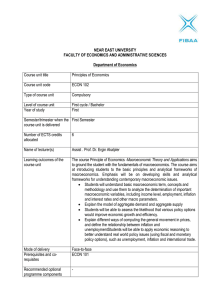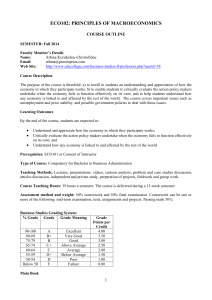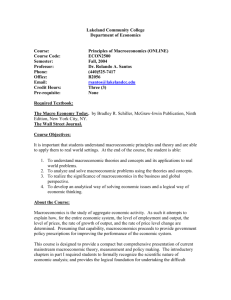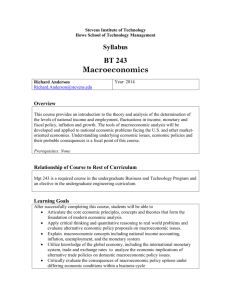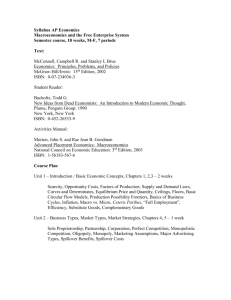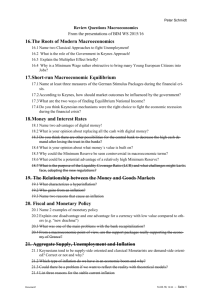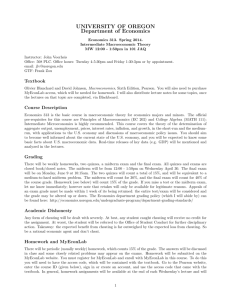Economics 2020 Section 010: Principles of Macroeconomics
advertisement
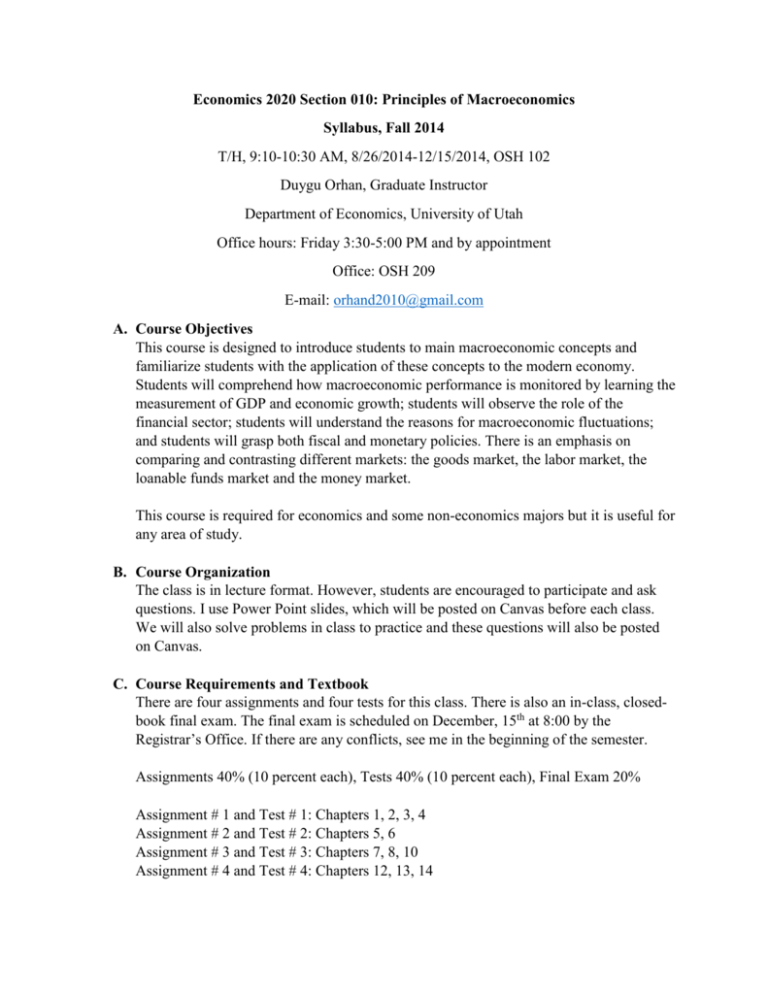
Economics 2020 Section 010: Principles of Macroeconomics Syllabus, Fall 2014 T/H, 9:10-10:30 AM, 8/26/2014-12/15/2014, OSH 102 Duygu Orhan, Graduate Instructor Department of Economics, University of Utah Office hours: Friday 3:30-5:00 PM and by appointment Office: OSH 209 E-mail: orhand2010@gmail.com A. Course Objectives This course is designed to introduce students to main macroeconomic concepts and familiarize students with the application of these concepts to the modern economy. Students will comprehend how macroeconomic performance is monitored by learning the measurement of GDP and economic growth; students will observe the role of the financial sector; students will understand the reasons for macroeconomic fluctuations; and students will grasp both fiscal and monetary policies. There is an emphasis on comparing and contrasting different markets: the goods market, the labor market, the loanable funds market and the money market. This course is required for economics and some non-economics majors but it is useful for any area of study. B. Course Organization The class is in lecture format. However, students are encouraged to participate and ask questions. I use Power Point slides, which will be posted on Canvas before each class. We will also solve problems in class to practice and these questions will also be posted on Canvas. C. Course Requirements and Textbook There are four assignments and four tests for this class. There is also an in-class, closedbook final exam. The final exam is scheduled on December, 15th at 8:00 by the Registrar’s Office. If there are any conflicts, see me in the beginning of the semester. Assignments 40% (10 percent each), Tests 40% (10 percent each), Final Exam 20% Assignment # 1 and Test # 1: Chapters 1, 2, 3, 4 Assignment # 2 and Test # 2: Chapters 5, 6 Assignment # 3 and Test # 3: Chapters 7, 8, 10 Assignment # 4 and Test # 4: Chapters 12, 13, 14 There are no required textbooks for this class. However, students are required to purchase Pearson’s MyEconLab to do the online homework assignments and tests. The students have the option to buy the online questions only (MyEconLab), or online questions that come with e-text, or online questions with printed text, or online questions with a 3-hole punch copy. We will have an expert from Pearson on the first day of class to explain how to buy MyEconLab from the website, if students prefer not to get it from the bookstore, and how to create an account in a few minutes. Parkin, Micheal. Macroeconomics. New Jersey: Pearson, 2013. 11th ed. D. Grade Scale A 93+ A90-92.99 B+ 87-89.99 B 82-86.99 B80-81.99 C+ 75-79.99 C CD+ D DE 70-74.99 65-69.99 63-64.99 57-62.99 50-56.99 <50 I round and curve the grades for the students that attend the lectures. E. Course Schedule Events Dates Classes begin Monday, August 25 Last day to add without a permission code Monday, Sept. 1 Last day to drop (delete) classes Wednesday, Sept. 3 Last day to add, elect CR/NC, or audit classes Monday, September 8 Last day to withdraw from classes Friday, October 24 Last day to reverse CR/NC option Friday, December 5 Classes end Friday, December 12 Reading day N/A Final exam period Mon.-Fri., Dec. 15-19 F. Course Outline WEEK 1 (August 26, August 28) Introduction Chapter 1: What is Economics? Chapter 2: The Economic Problem WEEK 2 (September 2, September 4) Chapter 3: Demand and Supply Chapter 4: Measuring GDP and Economic Growth WEEK 3 (September 9, September 11) Chapter 4: Measuring GDP and Economic Growth cont. Chapter 5: Monitoring Jobs and Inflation WEEK 4 (September 16, September 18) Chapter 6: Economic Growth WEEK 5 (September 23, September 25) Chapter 7: Finance, Saving and Investment WEEK 6 (September 30, October 2) Chapter 8: Money, the Price Level, and Inflation WEEK 7 (October 7, October 9) Chapter 8: Money, the Price Level, and Inflation cont. WEEK 8 FALL BREAK WEEK 9 (October 21, October 23) Chapter 10: Aggregate Supply and Aggregate Demand WEEK 10 (October 28, October 30) Chapter 10: Aggregate Supply and Aggregate Demand cont. WEEK 11 (November 4, November 6) Chapter 12: Inflation, Jobs, and the Business Cycle WEEK 12 (November 11, November 13) Chapter 12: Inflation, Jobs, and the Business Cycle cont. WEEK 13 (November 18, November 20) Chapter 13: Fiscal Policy WEEK 14 (November 25, November 27) Chapter 13: Fiscal Policy cont. & Thanksgiving Break WEEK 15 (December 2, December 4) Chapter 14: Monetary Policy WEEK 16 (December 9, December 11) Chapter 14: Monetary Policy cont. Review WEEK 17 (December 15) Final Exam G. Disclaimer The University of Utah seeks to provide equal access to its programs, services and activities for people with disabilities. If you will need accommodations in the class, reasonable prior notice needs to be given to the Center for Disability Services, 162 Olpin Union Building, 581-5020 (V/TDD). CDS will work with you and the instructor to make arrangements for accommodations. All information in this course can be made available in alternative format with prior notification to the Center for Disability Services. (www.hr.utah.edu/oeo/ada/guide/faculty/)

